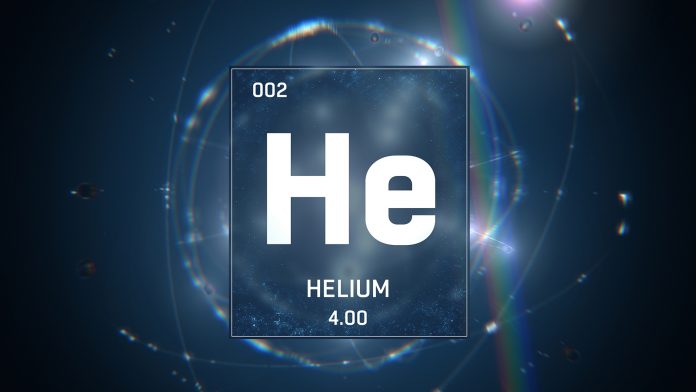Innovation News Network explores the vast clean energy, technological, and scientific uses of helium isotopes.
Due to the extensive uses of helium, the second lightest and second most abundant element in the Universe, it has been a subject of intrigue within the scientific community.
Specifically, the helium-3 isotope found on the lunar surface has garnered significant attention due to its immense potential in nuclear fusion reactions, which could provide clean and sustainable energy solutions for Earth’s ever-increasing power demands.
This article explores this fascinating element by delving into helium’s unique properties and behaviours under extreme conditions.
The fundamental properties of helium
The existence and behaviour of helium in space, particularly its isotopes, including helium-3 and helium-4, are subjects of immense academic interest.
While substantial quantities of helium-3 exist on the moon, potentially enough to power the United States for an entire year, understanding its fundamental properties under extreme conditions remains a complex scientific endeavour.

These isotopes exhibit unique characteristics under varying temperatures and pressures – factors often experienced in extra-terrestrial environments.
Helium’s fascinating phase transitions into a state of superfluidity at extremely low temperatures is a subject that intrigues physicists worldwide.
Superfluidity is a quantum mechanical phenomenon where matter behaves like a fluid with zero viscosity; it can flow without losing kinetic energy.
Helium in superfluidity showcases such intriguing behaviour when cooled to just two degrees above absolute zero (around -271°C), an area closely tied to the field of cryogenics.
This characteristic not only defies classical physics but also provides groundbreaking insights into quantum mechanics – the theory that governs particles at their most basic level.
The uses of helium because of these properties extend beyond mere intellectual curiosity. For instance, understanding how helium behaves under extreme cold has significant implications for technologies reliant on cryogenics, such as MRI scanners or particle accelerators.
Moreover, knowledge about helium isotopes’ characteristics contributes immensely towards advancements in nuclear fusion research – aiming at producing cleaner energy alternatives using resources like helium-3.
Thus, unravelling the mysteries surrounding this element underscores its potential significance in propelling technological progress while illuminating unknown facets of our Universe’s nature.
Role in advanced scientific research
In advanced scientific research, this noble gas is pivotal, particularly in conducting experiments under high-pressure and low-temperature scenarios.
Helium’s unique properties grant it an invaluable place in quantum mechanics studies, where its behaviour offers immense insight into understanding quantum phenomena.
Furthermore, helium’s superfluidity at extremely low temperatures provides opportunities for exploring applications in superconductivity. Research uses of helium include:
- Quantum Mechanics: Owing to its simple atomic structure and stability, helium is frequently used to test different models and theories within quantum physics;
- Superconductivity: The rare property of helium-4 becoming a superfluid at extremely low temperatures has been utilised to cool superconducting magnets, which are crucial components of MRI scanners;
- High Magnetic Fields: In conditions of high magnetic fields and low temperatures, electrons moving around the helium atom can reach quantised states leading to fractional quantum Hall effect, which is integral to condensed matter physics;
- Ultra-cold neutral plasmas: These plasmas enable scientists to study strongly correlated systems and many-body phenomena; and
- Astrophysics: Given that helium is found abundantly on Earth and the Sun and other stars, it holds relevance for astrophysics. It is also an effective tool for studying stellar atmospheres and interstellar medium due to its spectral lines being observable across vast cosmic distances.

Therefore, the various uses of helium, from facilitating groundbreaking discoveries in fundamental physics to aiding complex explorations in astrophysics, continue shaping our comprehension of the Universe.
Behaviour under immense pressure
Under immense pressure scenarios, the characteristics of this noble gas transform dramatically, presenting a fascinating area of study for researchers.
High-pressure experiments are key to understanding these transformations and offer insights into the intrinsic properties of helium at extreme conditions.
Helium compression is a unique process that leads to complex structural changes, fundamentally altering its atomic arrangements and behaviours. The helium response to pressure is unlike any other element due to its closed-shell electronic configuration and low atomic mass.
The exploration of extreme pressure behaviour in helium has revealed intriguing results. Under typical conditions, helium remains chemically inert owing to its complete electron shell structure; however, under tremendous pressure-induced circumstances, it exhibits remarkable chemical reactivity—a stark contrast from its conventional behaviour.
Pressure-induced changes in helium not only alter its physical state but also instigate unusual chemical activities with other elements which were previously deemed impossible.
The behaviour of helium under immense pressure indicates an array of potential applications ranging from advanced scientific research to energy production.
This anomalous behaviour can be harnessed in myriad ways, such as fusion reactions where highly compressed helium could serve as a potent fuel source or even as a medium for better understanding quantum mechanics and material science at high pressures.
Thus, further examination into the extreme states of this noble gas continues to broaden our comprehension of matter under extraordinary conditions while illuminating new avenues for technological advancement.

Changes at near-absolute zero temperatures
Transitioning to near-absolute zero temperatures introduces a new dimension, transforming the properties of this noble gas radically and giving rise to phenomena such as superfluidity.
Helium’s unique properties are dramatically pronounced under these freezing conditions. This can be attributed to quantum mechanical effects that become significant at extremely low temperatures.
The cryogenic behaviour of helium is intriguing, especially when it reaches a temperature close to absolute zero. At this point, helium doesn’t freeze like other elements but instead transforms into a superfluid – an exotic state of matter with zero viscosity.
The manifestation of helium’s unique properties at near absolute zero effects is truly fascinating and provides insight into its complex molecular structure and interactions.
For instance, in the superfluid phase, helium exhibits characteristics that defy common understanding: it flows without friction along surfaces. It can even climb up and over the sides of its container, ostensibly defying gravity in what is known as a Rollin film.
It also demonstrates infinite thermal conductivity, meaning that heat transferred into superfluid helium will move through it at maximum speed without causing any temperature gradient—unlike anything seen in ordinary fluids.
This ability for helium to transition from one state to another under extreme conditions makes it an excellent subject for studying low-temperature phenomena and quantum mechanics more broadly.
Its behaviour has been instrumental in developing our understanding of quantum theory, paving the way for advancements in condensed matter physics and nanotechnology.
Future uses of helium and research opportunities
Exploring prospective uses of helium and research opportunities presents a vast potential for scientific investigation and technological advancement in a range of settings, including:
Energy Production: Helium-3, a non-radioactive isotope abundant on the moon’s surface but rare on Earth, holds significant promise for future nuclear fusion reactors. This breakthrough could provide an efficient, sustainable energy source with minimal environmental impact;
Quantum Computing: The superconductivity of helium at ultra-low temperatures makes it ideal for cooling quantum computers’ delicate components. Future applications here could revolutionise computational power and speed;
Medicine: In medical imaging techniques like MRI scans, liquid helium cools down the system’s magnets, ensuring high-quality images are produced reliably; and
Space Exploration: Due to its abundance in outer space compared to Earth, helium has potential uses in life support systems or propulsion technologies for long-duration space missions.
Without a doubt, future uses of helium and research opportunities are set to redefine the boundaries of science while providing tangible benefits across multiple sectors globally.
Due to this, reinforcing helium supply chains will be critical to further research. Pioneering initiatives like Pulsar Helium’s Topaz and Tunu projects will be vital for satisfying the world’s growing helium needs.










